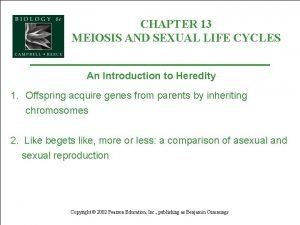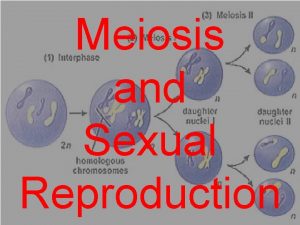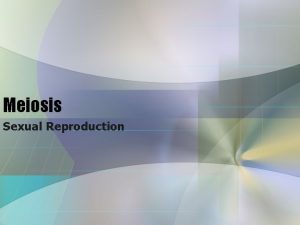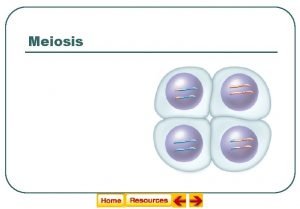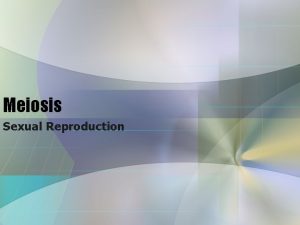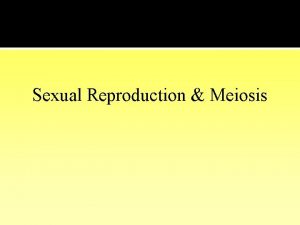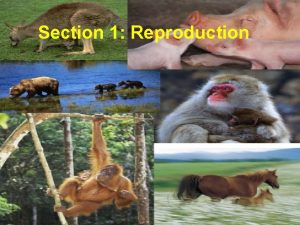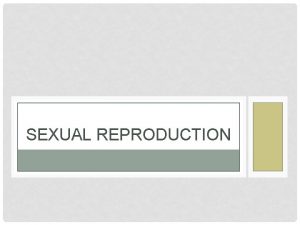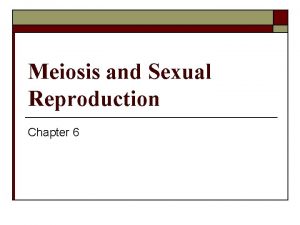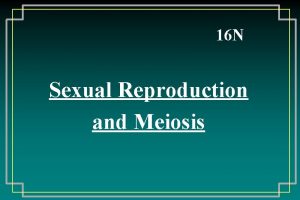Sexual Reproduction and Meiosis Chapter 8 Section 2












- Slides: 12

Sexual Reproduction and Meiosis Chapter 8 Section 2 p. 218 -223

A. Sexual Reproduction n Two sex cells, usually an egg and a sperm, come together

A. Sexual Reproduction n 1. Fertilization- the joining of an egg and a sperm, generally from two different organisms of the same species

A. Sexual Reproduction n 1. Fertilization- the joining of an egg and a sperm, generally from two different organisms of the same species n a. Sperm are formed in the male reproductive organs

A. Sexual Reproduction n 1. Fertilization- the joining of an egg and a sperm, generally from two different organisms of the same species a. Sperm are formed in the male reproductive organs n b. Eggs are formed in the female reproductive organs n

A. Sexual Reproduction n 1. Fertilization- the joining of an egg and a sperm, generally from two different organisms of the same species a. Sperm are formed in the male reproductive organs n b. Eggs are formed in the female reproductive organs n c. The new cell that forms from fertilization is a zygote n

A. Sexual Reproduction n 2. Following fertilization, mitosis begins and a new organism develops.

B. Cell Division in sex cells n 1. Body cells are diploid because they have 23 pairs of chromosomes

B. Cell Division in sex cells 1. Body cells are diploid because they have 23 pairs of chromosomes n 2. Sex cells are haploid because they have 23 single chromosomes (half a set) n

3. Meiosis n The process that produces haploid sex cells

3. Meiosis n The process that produces haploid sex cells n a. In Meiosis I, the nucleus divides and produces two new cells with one chromosome each.

3. Meiosis n The process that produces haploid sex cells n n a. In Meiosis I, the nucleus divides and produces two new cells with one chromosome each. b. In Meiosis II, the nuclei divide again and the chromatids separate, producing four cells with half the number of chromosomes of the original nucleus.
 Sexual reproduction and genetics section 1 meiosis
Sexual reproduction and genetics section 1 meiosis Chapter 10 section 3 gene linkage and polyploidy
Chapter 10 section 3 gene linkage and polyploidy Asexualk
Asexualk Sexual and asexual reproduction venn diagram
Sexual and asexual reproduction venn diagram Sexual and asexual reproduction venn diagram
Sexual and asexual reproduction venn diagram Chapter 10 sexual reproduction and genetics
Chapter 10 sexual reproduction and genetics Chapter 10 sexual reproduction and genetics
Chapter 10 sexual reproduction and genetics Chapter 13: meiosis and sexual life cycles
Chapter 13: meiosis and sexual life cycles Chapter 13 meiosis and sexual life cycles
Chapter 13 meiosis and sexual life cycles Sexual reproduction
Sexual reproduction Crossing over occurs during
Crossing over occurs during Chapter 10 section 1 meiosis answer key
Chapter 10 section 1 meiosis answer key Chapter 10 section 10.2 meiosis worksheet answer key
Chapter 10 section 10.2 meiosis worksheet answer key








